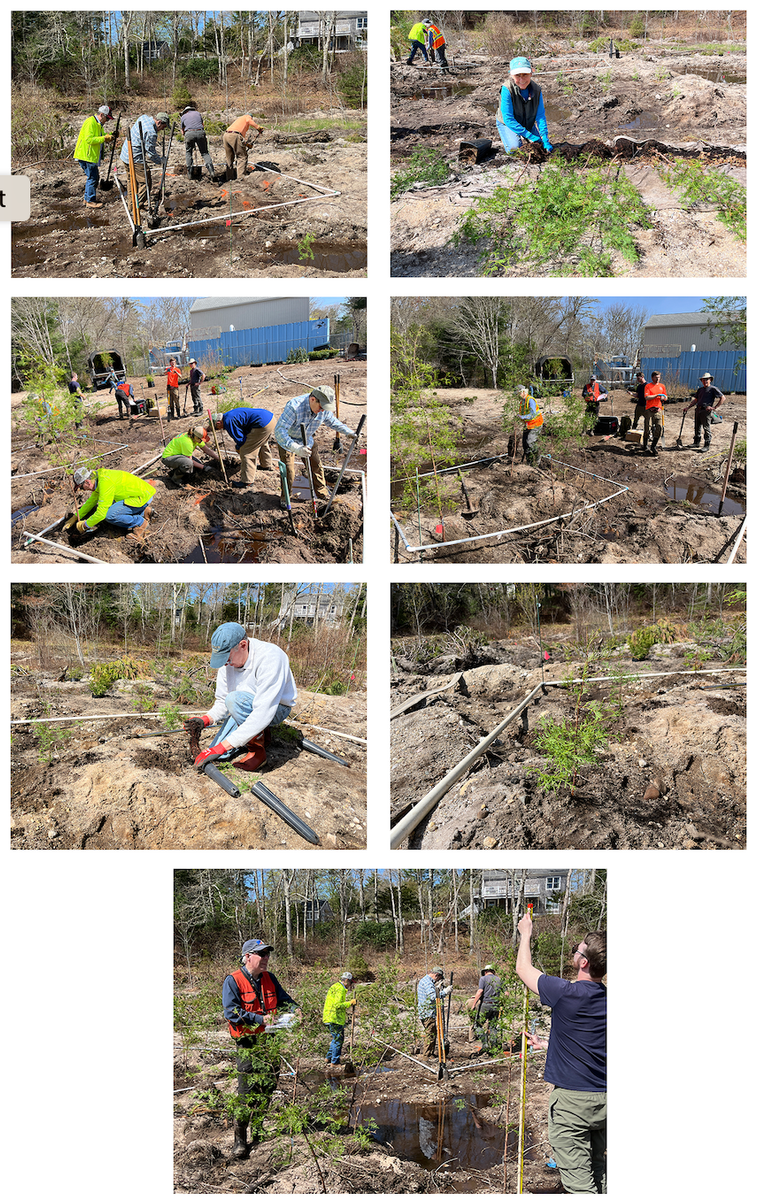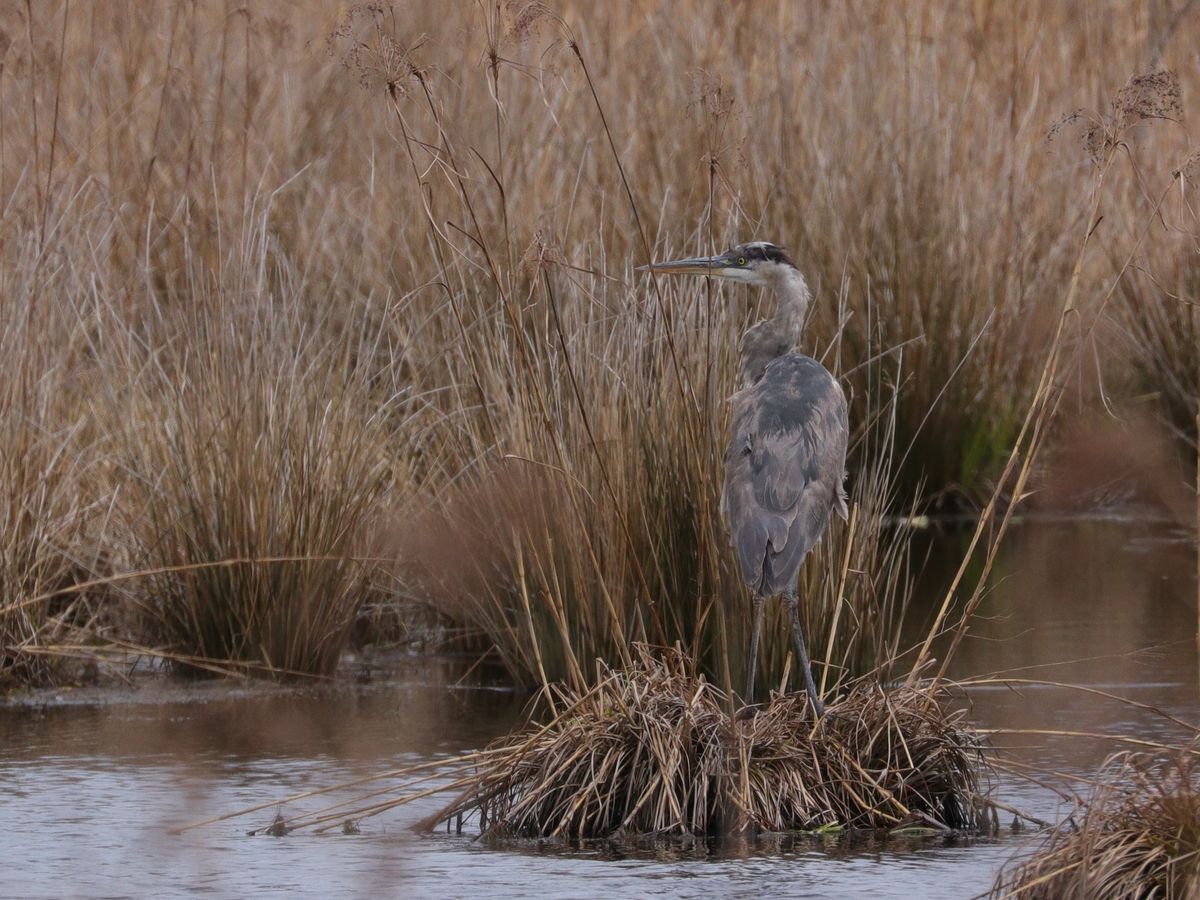Growing Atlantic White Cedars for Wetland Restoration Sites
Monitoring Atlantic White Cedar Plantings
Glorianna and volunteers planting AWC in block 1 (Cell A). Ponded areas, which were avoided, indicate low spots created by excavation of micro-topography.
This spring the LO nursery faced a dilemma. The nursery had a few hundred Atlantic white cedar (AWC) trees that had grown for at least five (5) years in the largest tree pot available. These cedars had outgrown their pots and needed a home at a welcoming restoration site.
For several years, the LO nursery team, who had supplied AWC for the Tidmarsh, lower and middle Coonamessett, and Childs river wetland restorations, had wondered whether younger trees with a strong root system could be successfully planted at these sites. Younger trees could be grown with less labor at a reduced cost, potentially encouraging land owners to plant at greater density.
As earthwork at the Upper Coonamessett River Wetlands Complex was close to completion, the nursery reached out to Betsy Gladfelter and Mark Kasprzyk, Falmouth’s Conservation Land Manager, to see if the Upper Coonamessett Wetland Complex would host an test planting to monitor survivorship of older and younger AWC trees.
With encouraging input from Bill Giuliano, Director of the Cranberry Bog Restoration Program at MA DER, an exploration of survivorship was developed using a randomized block design. The design required 4 blocks, with each block consisting of 6 plots laid out in a 3 by 2 orientation. In each row of three plots, we randomly assigned a treatment of young, old, and mixed age trees. Each plot measured 3 m by 3 m square; each plot was to contain 9 trees, roughly one every 1 sq. meter. In the mixed plots, the placement of young and old trees is randomly assigned, with the constraint that in each block there will be one plot with a 4/5 and one plot with a 5/4 young/old mix.
Atlantic white cedars (AWC) were already part of the planting program for the Upper Coonamessett restoration. In early April, Glorianna and I walked the site with Betsy, Mark, and Annie Spangenberger, InterFluve’s Project Manager for the restoration. Annie pointed to areas in cells A and B that she thought were large enough for the plantings we proposed and not too wet.
AWC thrives on the wetland margins and does not tolerate inundation of the tree collar, the area where the tree trunk meets the root system. Complicating factors for planting AWC on a restored sites include:
- Micro-topography that is implemented across the bog surface results in most areas having an array of dryer and wetter patches.
- As Christine Hatch’s monitoring of the Hydrologic Understory reveals, following the implementation of micro-topography ground water will take several months to a year to find new pathways at these sites.
In addition and particular to this site
- Downstream, a cranberry grower would be continuing operation; this could cause periodic flooding of the lower restored bog cells.
In mid-April, Adrian and Glorianna along with Chris Neill and Pat Farrar from Woodwell Climate Research Center met to lay out the plots for blocks 1 and 2 in Cell A. Then, on April 29, thanks to Mark Kasprzyk and an amazing group of volunteers, we transported the trees and completed the planting of these blocks (see photo above and blocks of photos below).
In mid-May, Adrian, Glorianna,and Pat reconvened to lay out the remaining blocks. The second proposed planting zone in Cell B was still way too wet. After a phone conversation with Annie, we identified another location on the south side of a pond in Cell C. Notably, the north side of this pond hosts a burial ground for phragmites australis, an experimental invasive control method that is being trialed at this location. These planting blocks should provide a scenic view as the site matures.
Glorianna and Pat Ferrar laying out block 4 (Cell C).
Site map with locations of planting plots, an example random block and mixed plot layout is given in the upper left corner, blocks are labeled in blue highlight, yellow highlight indicates plots/blocks that were moved because they were too wet.
The plots will be monitored based on the protocol developed by Chris Neill and Sara Klionsky for other DER monitoring locations. Each plot is marked with a fiberglass stake and given an ID number. Each tree is tagged and then measured for diameter, height, etc. The microtography within each plot means that the root collar of each tree is closer or further from the water table. In order to monitor the water table level and soil moisture, we will be placing soil moisture sensors and a piezometer in each block. The soils in each block will also be sampled and analyzed for physiochemical characteristics. Vegetation plots and soils are being monitored elsewhere at this restoration site, so vegetation community changes in these plots can be compared to the monitoring locations across the site.
Under natural conditions, AWC are a “disturbance” species that typically grow up in peaty wetlands following a fire or a blow down. Seeds may lay on the ground for several years before conditions are right for young trees to generate. As a stand of AWC matures, the trees that reach up 70 feet or more cut out sunlight and the swamp becomes dense and dark. Increasingly, as the light is minimized, seeds do not germinate or if they do the young AWC does not survive.
Planting AWC on restoration sites is challenging. How many trees should be planted to jump start an AWC stand? What is the optimum age or level of root development for these trees? How does recent disturbance of the soils due to microtopography impact tree survivorship and growth? How can we jump start an AWC stand?
In this exploration, we look at
differences in the survival and growth of AWC trees of different ages. Plots are planted with only older trees, only younger trees, or with trees of mixed age. While the age difference between these trees is not sufficient to explore the issue of regeneration in mature stands, the findings from this experiment could have implications for how AWC are grown and the age at which the trees are planted on other restored sites.
We will likely observe differences in growth rates and mortality of individual trees, as well as in plots that are planted differently. Some of these differences might be caused by the differences in root development between older and younger trees. While the younger trees have a strong root structure, the roots themselves are not as mature as the roots of older trees.
The microtopography in each plot creates variations that will be hard to account for. We avoided planting in areas where flooding mortality would almost certainly occur. We planted each tree so that the top of the roots (tree collar) rested at least ~10 cm above any standing water. However, some trees may still succumb to mortality due to flooding. We did not apply a strict tolerance for planting on mounds, so it is possible some trees placed on sandy mounds, especially the younger trees, may struggle initially due to lack of water. By measuring soil moisture (and/or groundwater depth) and monitoring individual trees, we may be able to detect mortality thresholds which can provide guidance for future planting.
If the younger trees establish and do well, the finding could encourage the planting of younger trees on future restoration sites. Procuring and planting younger trees could generate savings on a per plant basis, thereby allowing more AWC to be planted. If survivorship of trees in the mixed plots do better than trees in plots with only younger or only older trees, we can begin to speculate on why and we will have some data that can frame a future planting experiment. Additional data, including physiochemical development of soils, continuous measurement of the water table and soil moisture continuously within each block, and additional measurements of soil moisture at each tree during annual monitoring sessions using a handheld probe, may be helpful as we seek to refine planting plans for introducing AWC to these restoration projects.
Data and files for this experimental planting will be housed in the Upper Coonamessett River Wetlands Complex Restoration Project, linked below. Updates will be linked between to this project.
May 16, 2025







